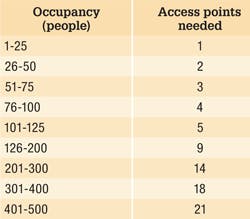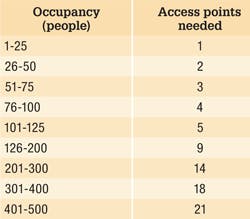Standard for educational facilities addresses cabling, wireless infrastructure
From the May, 2014 Issue of Cabling Installation & Maintenance Magazine
The recently completed ANSI/TIA-4966 standard, aimed at learning environments, also includes an annex on distributed antenna systems.
In fall 2013 the Telecommunications Industry Association (TIA: www.tiaonline.org) approved the ANSI/TIA-4966 Telecommunications Infrastructure Standard for Educational Facilities. The standard was developed within the association's TR-42.1 Subcommittee on Commercial Building Telecommunications Cabling over the course of approximately two years. It includes specific recommendations for the use of copper and fiber-optic cabling in educational facilities--specifically including primary and secondary schools as well as libraries--as well as recommendations for wireless communications within these facilities.
Like other recently completed TIA standards, 4966 addresses communications systems in specific environments (educational facilities). Similarly, the TIA's 942-A standard, finalized in spring 2012, addresses data center environments. And in 2010 the association completed the ANSI/TIA-1179 Healthcare Facility Telecommunications Infrastructure Standard. The ANSI/TIA-4966 standard devotes much of its content to components and systems specifically deployed in educational environments. And like 942-A and 1179, the 4966 standard references other TIA "common" and "component" standards. In particular, ANSI/TIA-4966 references the following ANSI/TIA standards.
- 568-C.0 (generic cabling)
- 569-C (pathways and spaces)
- 606-B (administration)
- 607-B (grounding/earthing and bonding)
- 862-A (building automation/systems)
- 568-C.2 (balanced twisted-pair cabling)
- 568-C.3 (optical fiber)
- 568-C.4 (coaxial)
Key among the standard's specifications are recommendations for the use of certain performance levels of cabling. For balanced twisted-pair cabling, the standard recommends the use of Category 6A; for optical-fiber cabling, ANSI/TIA-4966 recommends the use of Om3 or Om4. Additionally, the portion of the standard addressing fiber-optic cabling acknowledges that in practice, in educational-facility environments some horizontal cabling distances may exceed 100 meters. Nonetheless, the 4966 standard recommends 100-meter-maximum horizontal distances.
Specifications covering the deployment of coaxial cabling are covered by the standard's reference to 568-C.4.
Some of the standard's more noteworthy elements concern the infrastructure for wireless communication in educational facilities. TIA-4966 addresses the cabling for wireless access points, the density of such access points, and, via an informative annex, distributed antenna system (DAS) deployment.
The 4966 standard was completed and published shortly before the TIA completed and published the "A" revision of Telecommunications Systems Bulletin TSB-162 Telecommunications Cabling Guidelines for Wireless Access Points. Because TSB-162-A was still a work in progress while TIA-4966 was under development, the 4966 standard refers to the original TSB-162 when it addresses cabling for wireless access points.
In addition to that reference, the 4966 standard makes several standalone recommendations specific to educational facilities. For example, it makes recommendations for the density of access points within specified areas. The standard recommends placing 1 access point per 2,500 square feet of space in "general spaces" within educational facilities, and 1 access point per 1,600 square feet of space within residence halls.
Also, the table included in this article, reproduced from the ANSI/TIA-4966 standard, has been published in several papers and articles written by industry product and service providers. The table identifies recommended access-point densities based on a space's occupancy level.
As the TR-42.1 Subcommittee went through the process of developing the 4966 standard, it took into consideration the ability of DAS to meet the wireless-communication needs of many educational facilities. To that point, the standard includes an informative annex on DAS. The annex, approximately three pages in length, includes a generalized diagram of a DAS and discusses the components and media types frequently used in a DAS. As an informative annex, it is not part of the standard "proper" and does not have the same "rule of enforcement," so to speak, that the specifications within TIA-4966 have. Put differently, a communications system built for an educational facility does not have to contain a DAS in order to comply with 4966. If and when such a facility does include a DAS, the annex to 4966 can be used as an informative reference but does not prescribe specific components or systems as mandatory for compliance.
The group's work continues, as there now is a DAS Task Group within TR-42.1, which is in the early stages of developing a distinct set of specifications covering distributed antenna systems.
Another development that took place as the ANSI/TIA-4966 standard was coming together concerned cabling for security systems. The task group developing 4966 researched and gathered information on that topic, initially with the intention of including it in the standard. Ultimately, the TR-42.1 subcommittee determined the material gathered is applicable to all premises, not just educational facilities. So the information gathered was forwarded to the Network Security Task Group, which also is administered within TR-42.1. As of January 2014, the Network Security Task Group has posted a project authorization request and is working on a draft document. In all likelihood that document will enter the first stages of balloting, called mock balloting, within TR-42.1 later this year.
It is possible that these combined efforts ultimately produce an addendum to ANSI/TIA-4966 that addresses cabling for security systems, specifically applied to educational environments.
Editor's note: The ANSI/TIA-4966 standard, as well as other standards and TSBs mentioned in this article, can be obtained at "The TIA Store," a page on the Global Engineering Documents website: http://global.ihs.com/?rid=TIA.
Patrick McLaughlin is our chief editor.
Archived CIM Issues
About the Author
Patrick McLaughlin
Chief Editor
Patrick McLaughlin, chief editor of Cabling Installation & Maintenance, has covered the cabling industry for more than 20 years. He has authored hundreds of articles on technical and business topics related to the specification, design, installation, and management of information communications technology systems. McLaughlin has presented at live in-person and online events, and he has spearheaded cablinginstall.com's webcast seminar programs for 15 years.


